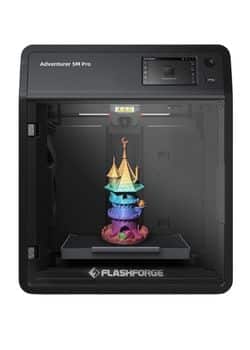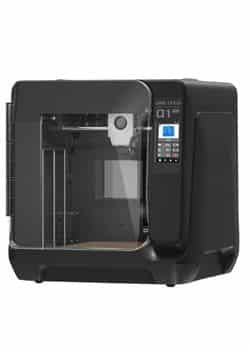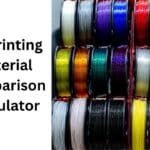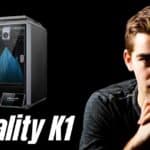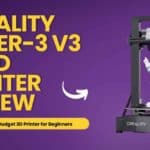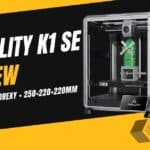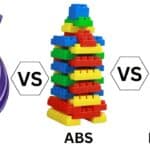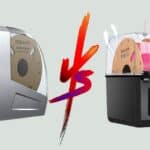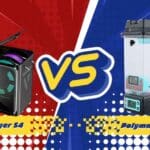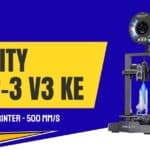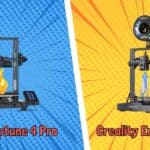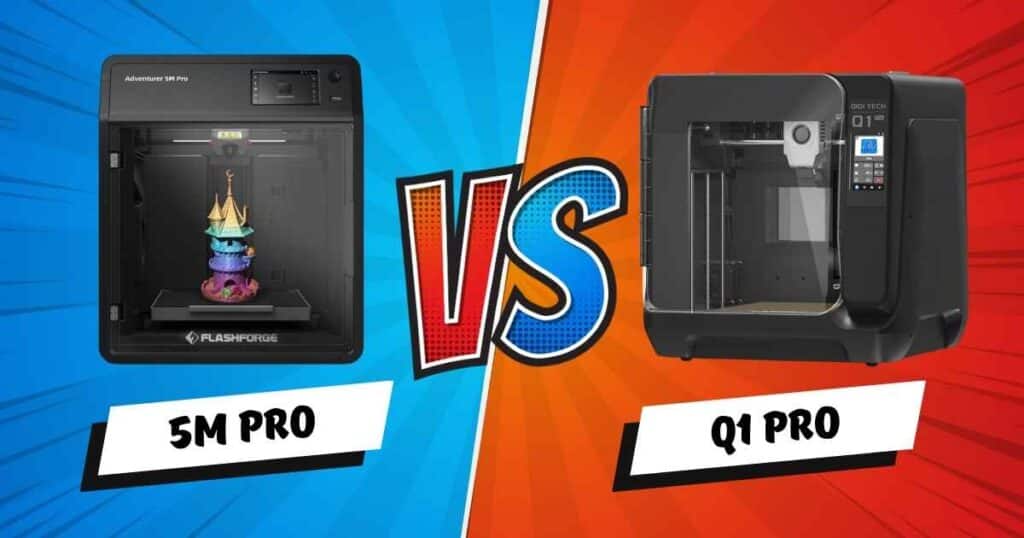
The world of 3D printing is buzzing with innovation, and 2025 finds enthusiasts spoiled for choice, especially in the “budget-friendly, high-performance” category. Two names consistently rise to the top of the conversation: the Flashforge Adventurer 5M Pro and the Qidi Q1 Pro. Both promise blazing-fast speeds, impressive print quality, and user-friendly features that belie their affordable price tags. But when every dollar counts and every print matters, which one truly reigns supreme?
Affiliate Disclosure
We participate in Amazon affiliate programs, earning fees from qualifying purchases via links at no extra cost to you. It’s how we keep this blog rolling and my 3D printers buzzing with fresh filament for reviews like this one!
This comprehensive head-to-head comparison dives deep into the specifications, performance, and real-world user experience of the Flashforge Adventurer 5M Pro and the Qidi Q1 Pro, helping you make an informed decision on which budget 3D printer wins in 2025.
Flashforge Adventurer 5M Pro vs Qidi Q1 Pro Quick Glance: Spec Sheet Showdown
Before we delve into the nuances, let’s look at the core specifications that define these machines.
| Feature | Flashforge Adventurer 5M Pro | Qidi Q1 Pro |
|---|---|---|
| Price (Est. 2025) | ~$399.00 | ~$429.00 |
| Build Volume | 220 x 220 x 220 mm (8.66″ x 8.66″ x 8.66″) | 245 x 245 x 240 mm (9.65″ x 9.65″ x 9.45″) |
| Max Print Speed | 600 mm/s | 600 mm/s |
| Max Acceleration | 20,000 mm/s² | 20,000 mm/s² |
| Extruder Type | Full-metal Direct Drive | Direct Drive (Multi-metal hot end hollow design) |
| Max Nozzle Temp | 280°C | 350°C |
| Max Bed Temp | Not specified (typical for general filaments) | Not specified (optimized for chamber) |
| Filament Compatibility | PLA, ABS, PETG, ASA, TPU, PC, PLA-CF, PETG-CF | PLA, PETG, TPU, PVA, PET, ABS, ASA, PA, PC, Carbon Fiber, Glass Fiber |
| Auto-Leveling | Pressure sensing, multi-point precision | Automated dual sensors, full-auto calibration |
| Enclosure | Fully Enclosed with dual circulation system (dust reduction) | Fully Enclosed with Active Heating Chamber (up to 60°C) |
| Connectivity | Wi-Fi, USB, Ethernet, Mobile APP (Flash Maker) | Wi-Fi, Mobile APP, 32G EMMC internal storage (no direct Ethernet port) |
| User Interface | Touchscreen (details not specified), Mobile App | Touchscreen (details not specified), Mobile App |
| Frame Structure | Core XY All-Metal | Dual Z-axis & CoreXY, Lightweight CoreXY system |
| Unique Features | Quick detachable 280°C nozzle, Auto shutdown, Resume printing, Filament detection, Remote video monitoring | 60°C Active Heating Chamber, Klipper-based (open source), Filament tangle detection, 1080P HD Camera |
| Item Weight | 32.1 Pounds | 44.97 Pounds |
| Dimensions (WxDxH) | 14.96″ x 15.75″ x 17.83″ | 18.78″ x 18.39″ x 19.25″ |
Deep Dive: Feature-by-Feature Comparison
Now, let’s break down what these specifications mean for your 3D printing experience.
Printing Speed & Performance
Both the Adventurer 5M Pro and the Q1 Pro boast impressive maximum print speeds of 600mm/s and acceleration rates of 20,000mm/s². This puts them squarely in the high-speed category, drastically reducing print times compared to older generation FDM printers.
The Flashforge Adventurer 5M Pro leverages its Core XY all-metal structure to ensure stability during these rapid movements, crucial for maintaining print quality at high speeds. Its nozzle heats up to 200°C in just 35 seconds, minimizing idle time. If you’re comparing it to other Flashforge models, you might find our Adventurer 5M vs 5M Pro comparison helpful.
The Qidi Q1 Pro also features a lightweight CoreXY system, enhanced by independent dual Z-axis motors, which contribute to greater precision and stability during high-speed printing. Users report excellent quality even at these accelerated rates. Qidi’s larger models, like the Qidi Max3, also showcase their commitment to performance.
Verdict: On paper, both printers offer identical top-tier speed and acceleration. Real-world performance will largely depend on the specific print, filament, and slicer settings. Neither holds a distinct advantage in raw speed metrics.
Print Quality & Precision
High speed means nothing without quality. Both manufacturers emphasize precision, even when printing fast.
The Adventurer 5M Pro highlights its robust Core XY structure and all-metal frame for stability, preventing wobbling and vibrations that can degrade print quality. The option for multiple nozzle sizes (0.25mm, 0.4mm, 0.6mm, 0.8mm) allows users to fine-tune between speed (larger nozzles) and intricate details (smaller nozzles), ensuring impeccable results for diverse projects. For more on optimizing prints, consider exploring our guide on best slicing software for 3D printing.
The Qidi Q1 Pro benefits from its dual Z-axis motors for enhanced precision, coupled with its actively heated chamber. This chamber, capable of reaching 60°C, significantly improves print quality and layer adhesion, particularly for “tricky” filaments prone to warping like ABS, PA, and PC. This feature is a game-changer for achieving structurally sound and aesthetically pleasing prints with engineering-grade materials.
Verdict: While Flashforge offers versatile nozzle options, the Qidi Q1 Pro’s actively heated chamber gives it a distinct edge in print quality and reliability, especially with advanced materials where thermal stability is paramount. This can mean the difference between a failed print and a perfect one when working with ABS or PC.
Ease of Use & Setup
Both printers target a user-friendly experience, promising quick setup times.
The Flashforge Adventurer 5M Pro boasts an “Unbox to print in 10 mins” claim. It features pressure sensing for automatic bed leveling, detecting platform height with multi-point precision, which eliminates manual adjustments and Z-axis calibration. The dual-sided PEI platform further simplifies model removal. Its integrated smart management via the Flash Maker mobile app offers remote video monitoring, real-time progress tracking, and parameter adjustments. If you’re curious about truly plug-and-play printers, check out Is the Flashforge Adventurer 5M Pro a truly plug and play 3D printer?
The Qidi Q1 Pro also claims a “Print Right Out of the Box” experience in just 10 minutes. It offers automated dual sensors for precise auto-leveling and intelligent Hall filament runout and tangle detection sensors, ensuring smooth operation. Users praise its “idiot-proof” nature for beginners, with perfect first layers consistently achieved without tinkering. For more options for beginners, see our best entry-level 3D printers 2025 guide.
Verdict: Both are excellent for ease of use, making them highly attractive to beginners. The Flashforge’s mobile app integration seems robust, while the Qidi’s filament tangle detection and reliable auto-leveling are highly valued by users for their ability to prevent print failures, making it slightly more “set it and forget it” for critical prints.
Build Volume & Design
A printer’s build volume determines the size of objects you can create, while its design influences where it fits and how it performs.
The Flashforge Adventurer 5M Pro offers a build volume of 220x220x220mm, which is a respectable size for most hobbyist and professional projects. Its compact dimensions (14.96″D x 15.75″W x 17.83″H) and all-metal Core XY structure contribute to its sturdy build. It features an enclosed chamber with a dual circulation system to reduce dust, contributing to a safer printing environment.
The Qidi Q1 Pro provides a slightly larger build volume at 245x245x240mm, offering a bit more room for bigger prints. Its physical dimensions are also larger (18.39″D x 18.78″W x 19.25″H) and it is heavier at 44.97 lbs, suggesting a more substantial frame. Crucially, its fully enclosed design includes an active heating chamber, which is a significant advantage for printing demanding materials and enhancing overall print success. For other large format options, consider our review of the Sovol SV08 Core XY 3D printer.
Verdict: The Qidi Q1 Pro wins on both counts: a larger build volume and the critical active heating chamber, which not only provides a cleaner printing environment but also actively enhances print quality for a wider range of materials. While both are enclosed, the Qidi’s heated chamber is a functional upgrade.
Software, Connectivity & Ecosystem
Modern 3D printers are increasingly connected, offering remote control and monitoring.
The Flashforge Adventurer 5M Pro supports input file formats like 3MF/STL/OBJ/FPP/BMP/PNG/JPG/JPEG and outputs GX/G code. It’s compatible with Linux, Mac OS, and Windows. Connectivity includes Wi-Fi, USB, Ethernet, and its proprietary Flash Maker mobile app for integrated smart management, including remote video monitoring and parameter adjustments. However, some users have reported issues with software installers being outdated for the latest MacOS versions, requiring an older OS or careful sourcing of updated software.
The Qidi Q1 Pro supports Gcode, STL, OBJ, 3MF, STEP, STP files and is compatible with Windows, MacOS, and Linux. It offers Wi-Fi connectivity and a mobile app for remote control, along with a generous 32GB EMMC super large internal storage. A key differentiator is that the Q1 Pro is Klipper-based and completely open source, allowing for custom optimization and greater flexibility for advanced users. While it supports Wi-Fi, some users might miss a dedicated Ethernet port for more reliable wired connectivity. It includes a 1080P HD camera for real-time monitoring and time-lapse photography.
Verdict: For beginners, both offer good app integration and standard connectivity. However, the Qidi Q1 Pro’s Klipper-based, open-source firmware and larger internal storage offer significant advantages for advanced users who want to tinker, optimize, and have more control over their printer. The Flashforge’s software compatibility issues with newer OS versions can be a hurdle.
Filament Compatibility & Advanced Materials
The range of materials a printer can handle directly impacts its versatility.
The Flashforge Adventurer 5M Pro supports a wide array of materials including PLA, ABS, PETG, ASA, TPU, PC, PLA-CF, and PETG-CF. Its robust full-metal direct extruder reaches 280°C, accommodating these versatile printing needs and ensuring precise results. For a deeper dive into filament types, refer to our PLA vs ABS vs PETG comparison and the ultimate guide to advanced 3D printing filaments.
The Qidi Q1 Pro takes material compatibility a step further. With a maximum nozzle temperature of 350°C and its multi-metal hot end hollow design (clog-free direct extruder), it can print PLA, PETG, TPU, PVA, PET, ABS, ASA, PA, PC, Carbon Fiber, and Glass Fiber filaments. The active heating chamber (up to 60°C) is crucial for successfully printing high-temperature, warp-prone materials like ABS, PA, and PC, providing superior layer adhesion and reduced warping.
Verdict: The Qidi Q1 Pro clearly wins in this category due to its higher maximum nozzle temperature (350°C vs. 280°C) and, more importantly, its active heating chamber. These features make it significantly more capable of handling a broader spectrum of advanced and engineering-grade filaments with greater success and reliability, crucial for functional prototypes and durable components.
Noise Levels & Safety Features
Quiet operation and safety are important, especially for home users.
The Flashforge Adventurer 5M Pro features a dual circulation system that also reduces dust, contributing to a safer and more convenient experience. While specific noise levels aren’t detailed, an enclosed design typically helps dampen sound. It includes auto shutdown, resume printing, and filament detection for optimized workflow and safety. The HEPA filtration system is also noted by users to do a great job keeping fumes down. Consider combining with an Amazon Smart Air Quality Monitor for 3D printers for peace of mind.
The Qidi Q1 Pro is fully enclosed, which inherently helps with noise and odor containment. It features smart sensors for filament runout and tangle detection to prevent print failures and reduce waste. An optional activated carbon air filter can be downloaded and printed, allowing users to enhance air purification for materials that emit fumes. However, it’s worth noting that the activated carbon filter is an optional add-on and not built-in by default, unlike the Adventurer 5M Pro’s stated dual circulation system. For more on air quality, explore best air purifiers for 3D printing workspaces.
Verdict: Both offer essential safety features and enclosed designs. The Flashforge Adventurer 5M Pro’s integrated dual circulation system and HEPA filtration seems to be a slight advantage for immediate air quality control without extra steps. The Qidi’s optional filter is a good solution, but requires user action.
Price & Value for Money (as of 2025)
Pricing is a significant factor for “budget” printers.
The Flashforge Adventurer 5M Pro is typically priced around $399.00. At this price point, it offers an incredible package of high speed, enclosed printing, auto-leveling, and broad material compatibility. For other great value options, check out our list of best 3D printers for every budget.
The Qidi Q1 Pro comes in slightly higher at approximately $429.00. For this additional investment, it offers a larger build volume, a higher maximum nozzle temperature, an active heating chamber, Klipper-based open-source firmware, and enhanced filament detection. Considering its features, some might argue it’s an ultimate solution for fast and flawless prints.
Verdict: While the Adventurer 5M Pro offers compelling value at its price, the Qidi Q1 Pro, despite being slightly more expensive, provides a superior feature set for the price, particularly the active heating chamber and Klipper integration. For many, the extra $30 is a worthwhile investment for these advanced capabilities, especially for users planning to print with more challenging materials.
Pros and Cons (Summary for each printer)
Flashforge Adventurer 5M Pro
Pros:
- Highly Accessible Price: Excellent value for an enclosed, high-speed printer. For more printers under $500, see our best entry-level 3D printers 2025.
- Blazing Fast Speeds: 600mm/s print speed and 20,000mm/s² acceleration.
- User-Friendly: “10-minute unbox to print,” pressure-sensing auto-leveling, dual-sided PEI plate.
- Robust Build: Core XY all-metal structure ensures stability.
- Integrated Air Filtration: Dual circulation system and HEPA filter for dust and fume reduction.
- Mobile App Integration: Comprehensive remote monitoring and control via Flash Maker.
- Quick Detachable Nozzle: Easy to swap for different detail levels or materials.
Cons:
- Lower Max Nozzle Temp: 280°C limits some advanced materials compared to Q1 Pro.
- No Active Heated Chamber: Less ideal for warp-prone materials like ABS, PC, PA compared to Q1 Pro.
- Software Compatibility Issues: Some users report difficulties with outdated installers on newer MacOS versions.
- Slightly Smaller Build Volume: 220mm cubed is good, but not as large as the Q1 Pro.
- Closed Source Firmware: Less flexibility for advanced customization compared to Klipper.
Qidi Q1 Pro
Pros:
- Active Heating Chamber (60°C): Crucial for printing advanced materials like ABS, PA, PC with minimal warping and superior layer adhesion.
- Higher Max Nozzle Temp (350°C): Expands material compatibility to truly high-performance filaments (e.g., Nylon, Carbon Fiber composites).
- Larger Build Volume: 245x245x240mm offers more printing space.
- Klipper-Based & Open Source: Provides immense customization and optimization potential for advanced users.
- Advanced Filament Detection: Includes both runout and tangle detection sensors, preventing print failures.
- Excellent Customer Service: Consistently praised for prompt and helpful support.
- Dual Z-axis & CoreXY: Enhances stability and precision for high-speed prints.
- 1080P HD Camera: Real-time monitoring and time-lapse photography built-in.
Cons:
- Slightly Higher Price: Marginally more expensive than the Adventurer 5M Pro.
- Optional Air Filter: Activated carbon filter is a printable add-on, not integrated by default.
- No Dedicated Ethernet Port: Relies on Wi-Fi for network connectivity (though 32GB internal storage mitigates some needs).
- Heavier and Larger Footprint: Might be a consideration for limited desk space.
- Flimsy Spool Mount: Some users report the side-mounted spool holder to be unstable (though printable solutions exist).
Who Should Buy Which Printer? (User Persona-Based Recommendations)
Choosing between these two excellent machines boils down to your specific needs, experience level, and priorities. If you’re still weighing your options, our ultimate 3D printer tier list 2025 offers a broader perspective.
Choose the Flashforge Adventurer 5M Pro if you are…
- A Beginner or Hobbyist: Looking for an incredibly easy-to-use, “unboxing-to-print” experience with reliable auto-leveling and a great mobile app. Check out our top 3D printer picks for beginners.
- Primarily Printing Common Materials: Focusing on PLA, PETG, TPU, and light ABS/ASA usage where an actively heated chamber isn’t a critical necessity.
- On a Strict Budget: Valuing maximum features for the lowest possible price.
- Concerned About Fumes/Dust: Appreciating the integrated dual circulation system and HEPA filtration for a cleaner environment.
- Space-Conscious: Needing a powerful enclosed printer with a slightly smaller footprint. You might also be interested in a comparison like Flashforge Adventurer 5M Pro vs Creality K1C.
Choose the Qidi Q1 Pro if you are…
- An Advanced User or Professional: Who values the power and flexibility of Klipper-based, open-source firmware for customization and optimization.
- Printing Engineering-Grade Materials: Regularly working with ABS, ASA, PA, PC, Carbon Fiber, or Glass Fiber, where the 350°C nozzle and active 60°C heated chamber are indispensable for successful, warp-free prints. Our guide on 3D printing material comparison can provide more insights.
- Seeking Ultimate Reliability: Valuing advanced features like filament tangle detection and superior customer service for peace of mind.
- Need a Larger Build Volume: For slightly bigger projects than the Adventurer 5M Pro offers.
- Willing to Pay a Little More: For a printer that offers a more robust material ecosystem and higher-end features. You can also explore the Qidi X-Max3 review for a large-format option.
Are there alternatives to consider?
While the Flashforge Adventurer 5M Pro and Qidi Q1 Pro are standout options, the budget high-speed market is competitive. Depending on your exact needs, you might also look at models like the Bambu Lab A1 series (for multi-color/material printing, though often open-air), the Creality K1C (another enclosed, high-speed option with a focus on carbon fiber), or the Elegoo Neptune 4 Pro (for a more open, yet fast and affordable Cartesian option). For broader comparisons, see Compare 3D Printers: Ultimate Tool to Find Your Perfect 3D Printer.
The Verdict: Which Budget Printer Wins in 2025?
In the dynamic landscape of 2025 budget 3D printers, declaring a single “winner” between the Flashforge Adventurer 5M Pro and the Qidi Q1 Pro isn’t straightforward. Both represent exceptional value and a significant leap in performance for their price points.
The Flashforge Adventurer 5M Pro is the undisputed champion for beginners, hobbyists, and those prioritizing ease of use and a pristine unboxing experience. Its integrated air filtration, robust Flash Maker app, and quick setup make it an incredibly approachable and powerful tool for getting into high-speed 3D printing with common materials. It’s truly a “set it and forget it” machine for many users, offering fantastic bang for your buck. If you’re solely focused on user-friendliness, it might be the best 3D printer under $300 in 2025.
However, for advanced users, small businesses, or anyone serious about printing demanding, engineering-grade materials, the Qidi Q1 Pro edges out its competitor. The active heating chamber (60°C) and the 350°C nozzle are game-changers for printing ABS, ASA, PA, PC, and composites successfully, minimizing warping and ensuring superior layer adhesion. The Klipper-based open-source firmware provides unparalleled flexibility for optimization, and the advanced filament detection, combined with Qidi’s highly praised customer service, offers a robust and reliable platform for more complex projects. The slightly larger build volume is also a welcome bonus.
Ultimately, in 2025, the Qidi Q1 Pro delivers more advanced features and material versatility for its slightly higher price, making it the stronger contender for those who push the boundaries of 3D printing. But for sheer plug-and-play simplicity and excellent performance with everyday filaments, the Flashforge Adventurer 5M Pro remains an incredibly compelling choice. Your ideal printer will be the one that best aligns with your personal printing goals.
Frequently Asked Questions (FAQs)
Is the Flashforge Adventurer 5M Pro good for beginners?
Absolutely! Its “10-minute unbox to print” setup, automatic bed leveling, and user-friendly Flash Maker app make it one of the most beginner-friendly high-speed 3D printers on the market. For more options, check our best beginner 3D printers of 2025.
Can the Qidi Q1 Pro print ABS?
Yes, and it excels at it! The Qidi Q1 Pro features an active heating chamber that reaches 60°C, which is specifically designed to prevent warping and improve layer adhesion when printing materials like ABS, ASA, PA, and PC. You can also review our guide on PLA vs ABS vs PETG for more material insights.
What’s the maximum speed of the Flashforge Adventurer 5M Pro?
The Adventurer 5M Pro boasts a maximum print speed of 600mm/s and an acceleration of 20,000mm/s².
Which printer has better community support?
Both Flashforge and Qidi have established communities, but Qidi’s embrace of open-source Klipper firmware for the Q1 Pro generally means a more active and knowledgeable community for troubleshooting and advanced modifications. Qidi’s direct customer service is also highly rated.
Is a Klipper-based system better for 3D printing?
For advanced users, yes. Klipper offers more control over printer hardware, allowing for advanced features like input shaping (to reduce ringing/ghosting), pressure advance, and extensive customization. It provides more granular control over printing parameters, often leading to higher quality and faster prints when properly configured.

